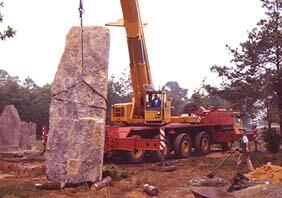- Home
- Discover the megaliths of Morbihan
- Reality and fantasy
- Heritage management
Basic principles
Megaliths belong to our archaeological heritage.
A European Convention on the Protection of the Archaeological Heritage was signed in Valetta (Malta) on January 16th, 1992. Its aim is to protect the archaeological heritage as a source of our common European heritage and as an instrument for historical and scientific study (art.1, § 1). In France, this convention is implemented by a series of laws and statutes.
Megaliths have always been considered by lawyers and scientists as unmovable property. This legal principle was reasserted in the late 19th century when some monuments were displaced (one of the dolmens of Kerran in Locmariaquer, was, for instance, taken to pieces and rebuilt in Meudon cemetery near Paris).
Many megaliths were listed or registered in the Record of Sites and Monuments which followed the introduction of the legislation on Historical Monuments. Their number increased after the December 31st, 1913 Act was passed.
The Morbihan monuments greatly benefited from the protective measures introduced by Z. Le Rouzic.
Since megalithic monuments are also archaeological sites, any work conducted on them also comes under the September 27th, 1941 Act regulating archaeological excavations.
A Kerran dolmen at Locmariaquer being dismantled before being transferred to the churchyard in Meudon.
Even with modern technology, large monoliths are hard to handle (here in Monteneuf).
The management of this heritage inevitably overlaps with other areas such as national or regional planning and local planning policy. It is then necessary to refer to the relevant legislation, i.e.:
- laws and statutes concerning archaeology
- legislation applicable to archaeological excavations
However, rights of public access are not clearly defined under this legislation and landowners retain extensive discretionary powers.
- If the historical monuments belong to the State, like the Carnac Alignments, the Centre for National Monuments (Centre des monuments nationaux) is responsible for public access ;
- Monuments owned by the Morbihan Department Council (Gavrinis, Petit Mont) are administered by the Société anonyme de Gestion du Morbihan (SAGEMOR), a ‘limited company’ in charge of the protection and promotion of the Morbihan. The SAGEMOR company also has responsibility for public access on a site belonging to several owners, such as Locmariaquer

